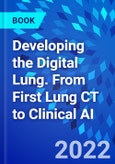-
Traces the development of precise quantitative CT of diffuse lung disease through the use of applied AI, leading to faster effective diagnosis of patients with lung disease.�
-
Reviews CT manufacturers, models and scanning protocol used to produce the 3D digital maps of the lungs.�
-
Discusses how the data processed by AI algorithms can produce measures of emphysema, air trapping, and airway wall thickening in subjects with COPD and measures of pulmonary fibrosis and traction bronchiectasis in idiopathic pulmonary fibrosis (IPF).�
-
Demonstrates the differences between reactive machine AI and limited memory AI methods.�
-
Includes comprehensive case studies and current information on cloud computing.�
-
An eBook version is included with purchase. The eBook allows you to access all of the text, figures and references, with the ability to search, customize your content, make notes and highlights, and have content read aloud.�
Table of Contents
Introduction
History of AI CT of the Lung
Lung CT Imaging Protocols and their role in enabling AICTL
Lung Segmentation, critical first step in AICTL
AI Lung Quantitative CT Metrics - Reactive Machine
AI Quantitative CT Metrics - Limited Memory Machine
How public and industry funded research drove AICTL
Adoption of AICTL into Clinical Radiology
Adoption of AICTL into Healthcare Enterprises
Future Directions








